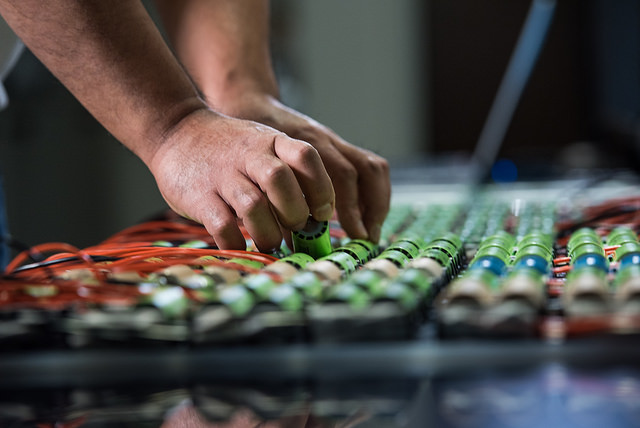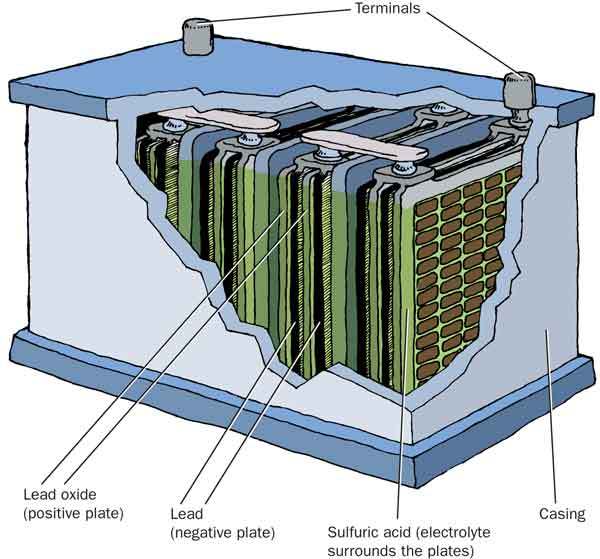Phone: (301) 352-5738
Email: info@CoastalClimateControl.com
Office | Warehouse:
1598 Whitehall Road, Suite D
Annapolis, Maryland 21409
Parallel Thinking Blown Sky High
 I saw some communications in a trade journal the other day discussing the common practice of wiring batteries in parallel to increase capacity. Specifically, one writer was warning of the possibility of a cell shorting in one of the batteries, resulting in the other batteries all discharging at a high rate of current into the short circuited cell leading to an apocalyptic event below decks. Is he/she correct? Well, yes and no.
I saw some communications in a trade journal the other day discussing the common practice of wiring batteries in parallel to increase capacity. Specifically, one writer was warning of the possibility of a cell shorting in one of the batteries, resulting in the other batteries all discharging at a high rate of current into the short circuited cell leading to an apocalyptic event below decks. Is he/she correct? Well, yes and no.
Yes, this is very much a possibility, but is dependent on battery type. An old timer, like yours truly, will probably adhere to the notion that the likelihood of a shorted cell is real, but that’s because our heads are still stuck in “the good old days”, and we are not being practical.
Let’s think about this. How can a cell, one of six in a 12 volt lead acid battery, become short circuited?
 In “traditional” flooded batteries, two lead plates, one positive and one negative in each cell, are suspended dangling in a bath of electrolyte with nothing but liquid between them. In this type of battery, there is indeed the possibility that the plates could come into contact with each other and cause a short circuit.
In “traditional” flooded batteries, two lead plates, one positive and one negative in each cell, are suspended dangling in a bath of electrolyte with nothing but liquid between them. In this type of battery, there is indeed the possibility that the plates could come into contact with each other and cause a short circuit.
For instance there could be a mechanical failure, where a lead component breaks off one of the plates and bridges across to the other, causing a short. Then there is owner abuse, i.e. when the electrolyte level is allowed to fall to a dangerous level, causing the plates to heat up and buckle under load or charging and make contact.
 I’m sure there are other scenarios in the “who’d a thought it?” category, where the resultant devastation made it difficult to determine the root cause. So yes, if you connect flooded batteries in parallel, especially if they are low-cost, non-marine items and/or they are abused or neglected, there is a distinct possibility of a shorted cell.
I’m sure there are other scenarios in the “who’d a thought it?” category, where the resultant devastation made it difficult to determine the root cause. So yes, if you connect flooded batteries in parallel, especially if they are low-cost, non-marine items and/or they are abused or neglected, there is a distinct possibility of a shorted cell.
But flooded lead acid batteries are becoming a rare breed on boats these days, and those to be found are typically high quality items that are unlikely to fail, or single batteries not connected to others. What we are more likely to find on board nowadays are batteries of Absorbed Glass Mat (AGM) or GEL construction.
 A shorted cell in an AGM battery is a highly unlikely event because the glass mat separator between the lead plates all but eliminates the possibility of any contact between the two, no matter how much abuse the battery is subjected to. I’m not so familiar with GEL battery construction, but I would imagine that they are less like to suffer shorted cells than flooded types, but not quite as immune as AGM’s.
A shorted cell in an AGM battery is a highly unlikely event because the glass mat separator between the lead plates all but eliminates the possibility of any contact between the two, no matter how much abuse the battery is subjected to. I’m not so familiar with GEL battery construction, but I would imagine that they are less like to suffer shorted cells than flooded types, but not quite as immune as AGM’s.
No matter what type of lead-acid batteries are connected in parallel, the risk of a major event from a shorted cell can be mitigated by the addition of fuses installed directly onto the positive post of each battery in the bank, as in this example at bluesea.com.
Once the fuse blows on the battery with the shorted cell, due to the excessive current rushing in to feed the short circuit, the danger is alleviated. I would hazard a guess here and say that, unless there are just two batteries in parallel, the only fuse likely to blow would be the one on the faulty battery, as the current flowing to the short circuit will be shared between the other batteries.
Once the fuse on the faulty battery blows, that battery is then isolated, and, as the cells in the battery are connected in series, the shorted cell will reduce the output voltage at the terminals to a nominal 10 volts.
There should now be little risk of any disastrous consequences, unless that is, the short circuit causes a spark above the level of the liquid electrolyte, in the area of explosive gas, and the whole kit and kaboodle blows to smithereens. The lower the level of electrolyte, the higher the volume of explosive gas, and so the bigger the bang.
So, in summary, to lessen the already low possibility of a parallel-wired, lead-acid battery bank self destructing from a shorted cell event, use good quality marine AGM batteries, and install Terminal Fuses of the appropriate rating on each battery.
Next time around I’ll share some test results from various multiple battery wiring configurations, so stay tuned.
By accepting you will be accessing a service provided by a third-party external to https://coastalclimatecontrol.com/






